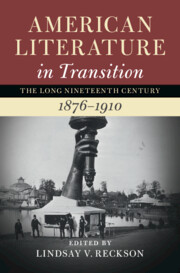Book contents
- American Literature in Transition, 1876–1910
- Nineteenth-Century American Literature in Transition
- American Literature in Transition, 1876–1910
- Copyright page
- Contents
- Contributors
- Series Preface
- Acknowledgments
- Chronology
- Introduction
- Part I Transitive States
- Part II Post-Reconstruction Aesthetics
- Part III Old Materialisms
- Chapter 11 Oil
- Chapter 12 Waste
- Chapter 13 Blood
- Chapter 14 Color
- Part IV Immanent Techniques
- Index
Chapter 14 - Color
from Part III - Old Materialisms
Published online by Cambridge University Press: 24 August 2022
- American Literature in Transition, 1876–1910
- Nineteenth-Century American Literature in Transition
- American Literature in Transition, 1876–1910
- Copyright page
- Contents
- Contributors
- Series Preface
- Acknowledgments
- Chronology
- Introduction
- Part I Transitive States
- Part II Post-Reconstruction Aesthetics
- Part III Old Materialisms
- Chapter 11 Oil
- Chapter 12 Waste
- Chapter 13 Blood
- Chapter 14 Color
- Part IV Immanent Techniques
- Index
Summary
Most of us experience the real world as colorful. Apples are red or green; the sky is blue or grey; your shirt is white or striped. The mundane objects of our lives come to us with and through their colors. It comes as a surprise, then, that realism – the literary style credited with having a fidelity to the real world – should be so lacking in colors, at least compared to its counterparts at the turn of the twentieth century. Scan the works of Henry James and Edith Wharton for color terms, and you’ll get the occasional description of an outfit, a room, a landscape. But these won’t be dwelt upon. This is due in part to the fact that the reality that realism commits itself to describing is, at heart, social reality rather than physical or even perceptual reality. If you search James and Wharton for “color” itself, you’ll mostly turn up instances of that preeminently social use of the term: Winterbourne “colors” when Daisy Miller bluntly invokes her “reputation”; Lily Bart’s “color deepens” when Selden suggests she come up to his room at The Bendick. And so on.
- Type
- Chapter
- Information
- American Literature in Transition, 1876–1910 , pp. 263 - 278Publisher: Cambridge University PressPrint publication year: 2022



